World War II's doodlebug hunters' 'lost story' told
- Published
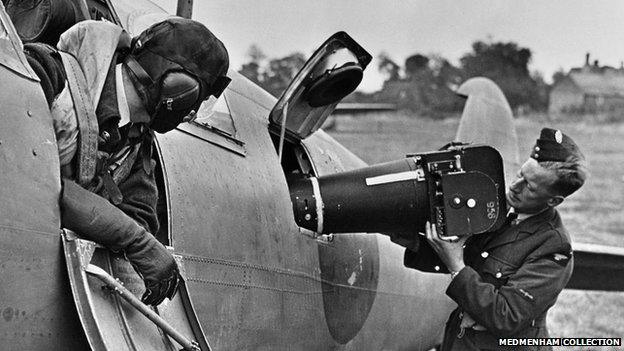
A camera for taking aerial photographs being loaded into an RAF aircraft
The lost story of the men and women who hunted for Hitler's "miracle weapons" is told for the first time in a new book, according to the publisher.
Operation Crossbow recalls the work of the Buckinghamshire-based Allied Central Interpretation Unit, which analysed millions of aerial images.
Weapons spotted in the photographs included V-1 flying bombs, which were nicknamed doodlebugs by Londoners.
The book features pictures taken by air crews based at Leuchars and Wick.
Author Allan Williams is curator of an archive of more than 25 million once top secret aerial photographs taken during World War II and the Cold War.
The collection is held by the Royal Commission on the Ancient and Historical Monuments of Scotland in Edinburgh.
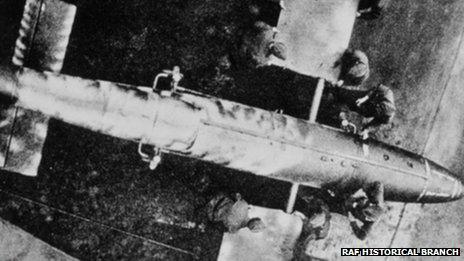
The new book recalls World War II's Operation Crossbow, an Allied effort to destroy German weapons such as the V-1 flying bomb
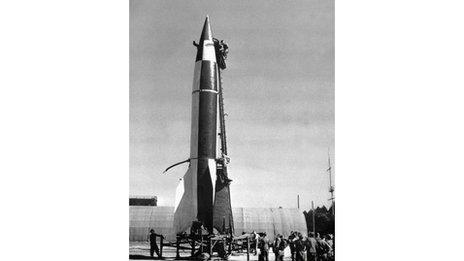
The V-2 rocket was another of Hitler's so-called "miracle weapons" targeted in the operation
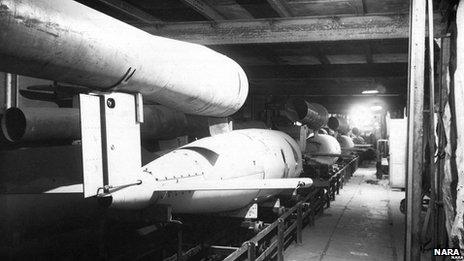
The book's war-time images include photographs taken by RAF and US air crews
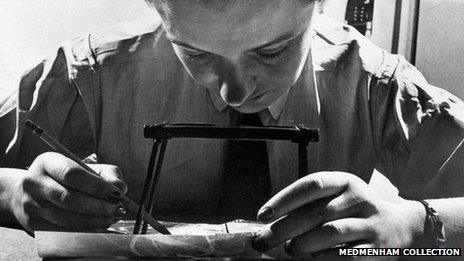
Constance Babington Smith was among ACIU's leading interpreters of aerial photographs of V weapon and jet aircraft sites

Other RAF Medmenham photographic interpreters included the actor Dirk Bogarde, far left

Pilot Gordon Hughes, left, made some of the earliest Allied photographic sorties
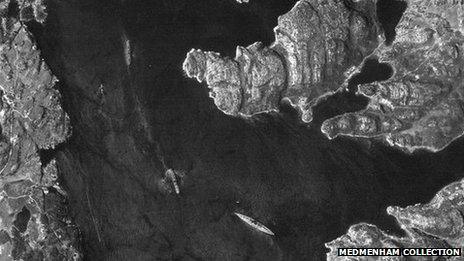
The book's photographs include one taken of the German battleship, the Bismarck, by pilot who was stationed at RAF Wick
Released by Preface Publishing, the book takes its name from the codename for the Allied effort to destroy German rockets and jet aircraft at sites in Germany and occupied Holland.
Dubbed "miracle weapons" by Hitler, they included V-1 flying bombs, V-2 rockets, Me262 jet fighter-bombers and rocket-propelled Me163 planes.
The first V-1s were launched against London on 12 June 1944.
The distinctive buzzing sound of its engine led the weapon being nicknamed the buzz bomb and doodlebug. The bombs would fall silent in the final moments as they fell to the ground.
Writer Evelyn Waugh described them as an "impersonal plague" of "enormous, venomous insects".
Me262s were flown against US bombers, a tactic portrayed in Star Wars director George Lucas' 2012 film, Red Tails.
The Allied Central Interpretation Unit (ACIU) was based at RAF Medmenham.
Its leading figures included World War I veteran Frederick Winterbotham and Australian entrepreneur and inventor Sidney Cotton. Cotton was key to developing the capability of RAF photographic reconnaissance.
Constance Babington Smith, external also appears in the new book. She was a star interpreter of aerial photographs at ACIU and was the first to spot a V-1 being prepared for a test flight.
Babington Smith's discovery played a part in the RAF's decision to launch Operation Crossbow.
Pilot Gordon Hughes, external flew reconnaissance sorties during the operation. A V-2 launching from a site on Germany's Baltic coast was among the many images he took.
During his war-time service, Hughes, who died in June last year, also flew from air stations in Scotland on long-range sorties in search of German warships off northern Norway and also Poland.
In the book are also images taken by air crews that flew out of RAF Leuchars in Fife and RAF Wick in Caithness.
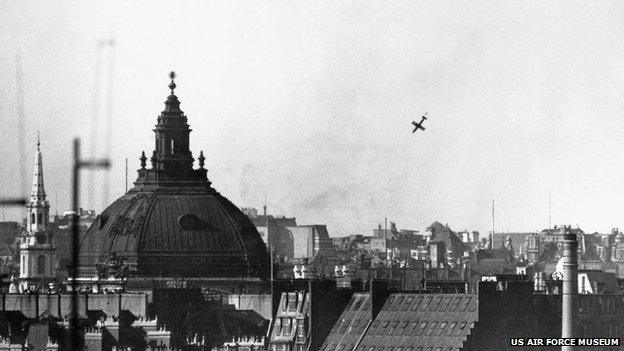
A V-1 flying bomb falling over the Victoria district of central London
One of the RAF Wick images is of the Bismarck, the largest battleship in the German navy.
Mr Williams said the new book recalled the crucial work of reconnaissance squadrons and the interpretation unit.
He said: "The imagery that survives in the collection relating to Operation Crossbow shows the extent of the search for test and launch sites - which involved taking over 1.2 million aerial photographs - and the great efforts made by the Germans to camouflage the sites.
"It also tells the story of the dramatic response of the Allied air forces when targets were pinpointed.
"Without this photographic intelligence - which was created at remarkable speed - the Germans could have launched potentially devastating attacks on Britain before D-Day that could have easily changed the outcome of the war."